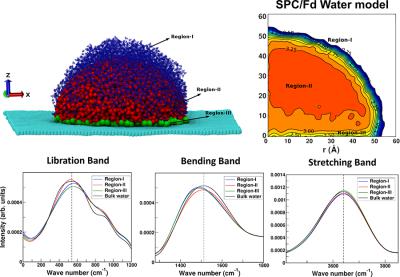当前位置:
X-MOL 学术
›
J. Comput. Chem.
›
论文详情
Our official English website, www.x-mol.net, welcomes your
feedback! (Note: you will need to create a separate account there.)
Development of non-bonded interaction parameters between graphene and water using particle swarm optimization
Journal of Computational Chemistry ( IF 3.4 ) Pub Date : 2017-12-19 , DOI: 10.1002/jcc.25141 Karteek K. Bejagam 1 , Samrendra Singh 2 , Sanket A. Deshmukh 1
Journal of Computational Chemistry ( IF 3.4 ) Pub Date : 2017-12-19 , DOI: 10.1002/jcc.25141 Karteek K. Bejagam 1 , Samrendra Singh 2 , Sanket A. Deshmukh 1
Affiliation

|
New Lennard‐Jones parameters have been developed to describe the interactions between atomistic model of graphene, represented by REBO potential, and five commonly used all‐atom water models, namely SPC, SPC/E, SPC/Fw, SPC/Fd, and TIP3P/Fs by employing particle swarm optimization (PSO) method. These new parameters were optimized to reproduce the macroscopic contact angle of water on a graphene sheet. The calculated line tension was in the order of 10−11 J/m for the droplets of all water models. Our molecular dynamics simulations indicate the preferential orientation of water molecules near graphene–water interface with one OH bond pointing toward the graphene surface. Detailed analysis of simulation trajectories reveals the presence of water molecules with ≤∼1, ∼2, and ∼4 hydrogen bonds at the surface of air–water interface, graphene–water interface, and bulk region of the water droplet, respectively. Presence of water molecules with ≤∼1 and ∼2 hydrogen bonds suggest the existence of water clusters of different sizes at these interfaces. The trends observed in the libration, bending, and stretching bands of the vibrational spectra are closely associated with these structural features of water. The inhomogeneity in hydrogen bond network of water at the air–water and graphene–water interface is manifested by broadening of the peaks in the libration band for water present at these interfaces. The stretching band for the molecules in water droplet shows a blue shift as compared to the pure bulk water, which conjecture the presence of weaker hydrogen bond network in a droplet. © 2017 Wiley Periodicals, Inc.
中文翻译:

使用粒子群优化开发石墨烯和水之间的非键相互作用参数
开发了新的 Lennard-Jones 参数来描述以 REBO 势为代表的石墨烯原子模型与五种常用的全原子水模型(即 SPC、SPC/E、SPC/Fw、SPC/Fd 和 TIP3P)之间的相互作用/Fs 通过采用粒子群优化 (PSO) 方法。这些新参数经过优化,可重现水在石墨烯片上的宏观接触角。对于所有水模型的液滴,计算出的线张力约为 10-11 J/m。我们的分子动力学模拟表明,石墨烯-水界面附近的水分子优先取向,其中一个 OH 键指向石墨烯表面。对模拟轨迹的详细分析揭示了在空气-水界面表面存在≤~1、~2和~4个氢键的水分子,分别为石墨烯-水界面和水滴的主体区域。具有≤~1 和~2 个氢键的水分子的存在表明在这些界面处存在不同大小的水簇。在振动光谱的振动、弯曲和拉伸带中观察到的趋势与水的这些结构特征密切相关。空气-水和石墨烯-水界面处水的氢键网络的不均匀性表现为这些界面处存在的水的振动带中的峰变宽。与纯水相比,水滴中分子的伸缩带显示蓝移,这推测水滴中存在较弱的氢键网络。© 2017 威利期刊公司。具有≤~1 和~2 个氢键的水分子的存在表明在这些界面处存在不同大小的水簇。在振动光谱的振动、弯曲和拉伸带中观察到的趋势与水的这些结构特征密切相关。空气-水和石墨烯-水界面处水的氢键网络的不均匀性表现为这些界面处存在的水的振动带中的峰变宽。与纯水相比,水滴中分子的伸缩带显示蓝移,这推测水滴中存在较弱的氢键网络。© 2017 威利期刊公司。具有≤~1 和~2 个氢键的水分子的存在表明在这些界面处存在不同大小的水簇。在振动光谱的振动、弯曲和拉伸带中观察到的趋势与水的这些结构特征密切相关。空气-水和石墨烯-水界面处水的氢键网络的不均匀性表现为这些界面处存在的水的振动带中的峰变宽。与纯水相比,水滴中分子的伸缩带显示蓝移,这推测水滴中存在较弱的氢键网络。© 2017 威利期刊公司。在振动光谱的振动、弯曲和拉伸带中观察到的趋势与水的这些结构特征密切相关。空气-水和石墨烯-水界面处水的氢键网络的不均匀性表现为这些界面处存在的水的振动带中的峰变宽。与纯水相比,水滴中分子的伸缩带显示蓝移,这推测水滴中存在较弱的氢键网络。© 2017 威利期刊公司。在振动光谱的振动、弯曲和拉伸带中观察到的趋势与水的这些结构特征密切相关。空气-水和石墨烯-水界面处水的氢键网络的不均匀性表现为这些界面处存在的水的振动带中的峰变宽。与纯水相比,水滴中分子的伸缩带显示蓝移,这推测水滴中存在较弱的氢键网络。© 2017 威利期刊公司。空气-水和石墨烯-水界面处水的氢键网络的不均匀性表现为这些界面处存在的水的振动带中的峰变宽。与纯水相比,水滴中分子的伸缩带显示蓝移,这推测水滴中存在较弱的氢键网络。© 2017 威利期刊公司。空气-水和石墨烯-水界面处水的氢键网络的不均匀性表现为这些界面处存在的水的振动带中的峰变宽。与纯水相比,水滴中分子的伸缩带显示蓝移,这推测水滴中存在较弱的氢键网络。© 2017 威利期刊公司。
更新日期:2017-12-19
中文翻译:

使用粒子群优化开发石墨烯和水之间的非键相互作用参数
开发了新的 Lennard-Jones 参数来描述以 REBO 势为代表的石墨烯原子模型与五种常用的全原子水模型(即 SPC、SPC/E、SPC/Fw、SPC/Fd 和 TIP3P)之间的相互作用/Fs 通过采用粒子群优化 (PSO) 方法。这些新参数经过优化,可重现水在石墨烯片上的宏观接触角。对于所有水模型的液滴,计算出的线张力约为 10-11 J/m。我们的分子动力学模拟表明,石墨烯-水界面附近的水分子优先取向,其中一个 OH 键指向石墨烯表面。对模拟轨迹的详细分析揭示了在空气-水界面表面存在≤~1、~2和~4个氢键的水分子,分别为石墨烯-水界面和水滴的主体区域。具有≤~1 和~2 个氢键的水分子的存在表明在这些界面处存在不同大小的水簇。在振动光谱的振动、弯曲和拉伸带中观察到的趋势与水的这些结构特征密切相关。空气-水和石墨烯-水界面处水的氢键网络的不均匀性表现为这些界面处存在的水的振动带中的峰变宽。与纯水相比,水滴中分子的伸缩带显示蓝移,这推测水滴中存在较弱的氢键网络。© 2017 威利期刊公司。具有≤~1 和~2 个氢键的水分子的存在表明在这些界面处存在不同大小的水簇。在振动光谱的振动、弯曲和拉伸带中观察到的趋势与水的这些结构特征密切相关。空气-水和石墨烯-水界面处水的氢键网络的不均匀性表现为这些界面处存在的水的振动带中的峰变宽。与纯水相比,水滴中分子的伸缩带显示蓝移,这推测水滴中存在较弱的氢键网络。© 2017 威利期刊公司。具有≤~1 和~2 个氢键的水分子的存在表明在这些界面处存在不同大小的水簇。在振动光谱的振动、弯曲和拉伸带中观察到的趋势与水的这些结构特征密切相关。空气-水和石墨烯-水界面处水的氢键网络的不均匀性表现为这些界面处存在的水的振动带中的峰变宽。与纯水相比,水滴中分子的伸缩带显示蓝移,这推测水滴中存在较弱的氢键网络。© 2017 威利期刊公司。在振动光谱的振动、弯曲和拉伸带中观察到的趋势与水的这些结构特征密切相关。空气-水和石墨烯-水界面处水的氢键网络的不均匀性表现为这些界面处存在的水的振动带中的峰变宽。与纯水相比,水滴中分子的伸缩带显示蓝移,这推测水滴中存在较弱的氢键网络。© 2017 威利期刊公司。在振动光谱的振动、弯曲和拉伸带中观察到的趋势与水的这些结构特征密切相关。空气-水和石墨烯-水界面处水的氢键网络的不均匀性表现为这些界面处存在的水的振动带中的峰变宽。与纯水相比,水滴中分子的伸缩带显示蓝移,这推测水滴中存在较弱的氢键网络。© 2017 威利期刊公司。空气-水和石墨烯-水界面处水的氢键网络的不均匀性表现为这些界面处存在的水的振动带中的峰变宽。与纯水相比,水滴中分子的伸缩带显示蓝移,这推测水滴中存在较弱的氢键网络。© 2017 威利期刊公司。空气-水和石墨烯-水界面处水的氢键网络的不均匀性表现为这些界面处存在的水的振动带中的峰变宽。与纯水相比,水滴中分子的伸缩带显示蓝移,这推测水滴中存在较弱的氢键网络。© 2017 威利期刊公司。









































 京公网安备 11010802027423号
京公网安备 11010802027423号